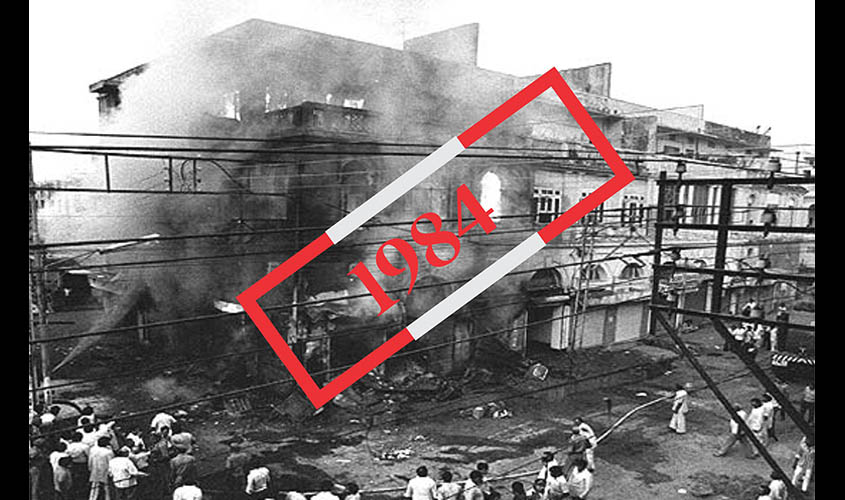The horrific anti-Sikh riots of 1984 are etched permanently in the memory of those who covered the most deplorable and reprehensible act in the history of Independent India. It was a sight which simply cannot be forgotten, and the manner in which innocent Sikhs were slaughtered following the equally brutal assassination of the then Prime Minister Indira Gandhi, could only be described as nothing short of barbaric. It indeed is a matter of deep anguish that many of those responsible for this genocide have remained unpunished, a dismal reflection on how the criminal justice system works in our country.
Ahead of the 2019 parliamentary polls, the controversy over the involvement of the Congress has been reignited, in the wake of Rahul Gandhi’s comments in London that his party was institutionally not responsible for the carnage. His observations have been echoed by Punjab Chief Minister, Captain Amarinder Singh, who has gone on record to name some individual Congress leaders connected to the bloodbath, while simultaneously rejecting the complicity of the entire organisation in the dastardly crime. Incidentally, Singh had quit the Congress after Operation Blue Star, and his views were based on his conversation with the victims while the riots were ablaze.
It is another story that even after 34 years, none of the front ranking leaders who were accused of inciting mobs have been convicted by any court of law. The majority of Sikhs remain unconvinced that these leaders had no role, and for them justice would only be served if the law booked those whom they believe to be the prime perpetrators.
Parallels have been drawn by the political class bracketing the 1984 massacre and the mayhem in Gujarat in 2002, following the Godhra incident where kar sevaks returning from Ayodhya were burnt alive. The context of both the incidents, equally condemnable, was completely different, and thus should be understood in that light. The Gujarat riots evoked sharp criticism from the then Prime Minister Atal Bihari Vajpayee, who advised the state government to observe Raj Dharma (tenets of governance) while dealing with the issue. He made the statement when reports appeared that the anarchy was state sponsored.
The 1984 riots took place after Indira Gandhi, described universally as the greatest mass leader of the last century, was assassinated on 31 October to avenge Operation Blue Star by Sikh bodyguards whose duty was to protect her with their lives. During the operation in June, the Indian Army had entered the Golden Temple complex, to neutralise militants led by Jarnail Singh Bhindranwale who had taken refuge in the compound. In the process, the Army inflicted heavy damage on buildings around the Harmandar Saheb. This had disconcerted the Sikhs, who in protest against the desecration of the holy shrine did not celebrate Dipavali that year.
At the same time, rage had also been mounting amongst the Hindus in Punjab since hordes of innocent people were being targeted by the militants on the basis of religion and were being methodically executed. Though initially Indira Gandhi was reluctant to order the Army into the shrine, she gave in, on being pressurised by Arun Nehru and some of her close aides. However, soon after the Prime Minister was gunned down, a rumour was afloat in the capital that the Sikhs were celebrating her death and distributing sweets.
The fury amongst the people was spiralling and Arun Nehru is said to have given instructions to some of his acolytes to “teach them a lesson”. The Delhi Police was unable to control law and order since it was totally demoralised on being accused of killing the Prime Minister. All hell broke loose, and there was no semblance till the Army stepped in and the Gorkhas, in large parts, brought the situation under control. By that time, nearly 3,000 Sikhs had already been butchered, putting an indelible blot on the history of the country. It is a travesty of justice that no principal leader of the Congress or any police officer, has been found guilty, though the Ved Marwah report did cast aspersions on many top functionaries. The report never saw the light of day.
Another matter of paramount concern is that the plight of the 1984 riot survivors remains pitiable. Successive governments have been unable to bring any succour to them, and so have failed in providing a healing touch. Millions of dollars have been sent by NRIs, mostly Sikhs residing in the US, Australia, Canada and the UK, for their rehabilitation, but it is evident that a large amount of money has not reached them. Some vested interests have squandered huge sums and continue to indulge in low level politics in their name. The supreme tragedy is that the plight of the victims is pathetic, and if they are surviving, it is solely because of their indomitable will. In addition they have the support of public-spirited individuals, and select Sikh institutions that continue to facilitate their living.
It would be in the fitness of things that while demanding justice for the victims, efforts are also made to trace the missing money that should have justifiably reached the survivors. The government possesses the mechanism to track down foreign donations and ascertain how the funds have been misappropriated. If there are people or institutions that have embezzled the monetary assistance, strict action should be initiated against them. The victims need closure. This will be possible only through court convictions and financial aid. Between us.

